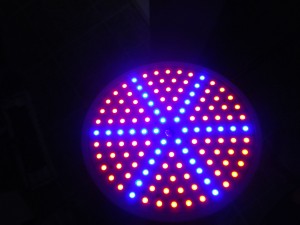When browsing eBay for grow leds, one of the really common E27 bulbs that kept showing up (which you might recognize if you’ve been doing some searching yourself) was this one:
It was $10. It looked cheaply made. Heck, it only advertised 2 spectrums (445nm and 660nm).
I was curious.
Here’s the gist, at a glance:
- It actually pulls 3W. I doubt it would grow anything on it’s own. Might be useful to “extend daylight” if you have indoor plants by the window that go dormant when days get shorter in the fall.
- 49 volts at the leads.
- As for current… wattage is low enough that rounding errors really come into play, but if we pretend it was exactly 3W, that works out to about 60mA. There are 6 parallel runs, so 10mA per run.
- One of the LEDs was soldered somewhat diagonally.
- There was a bit of mess from the flux where they soldered the wires to the PCB.
- It’s extremely light in weight.
—
It’s not very bright – I was able to look at it for periods of about 10 seconds each, though I did end up with yellow spots in my vision for a few minutes afterward.
I didn’t have much luck determining exactly which LEDs they are. With a ruler (and my poor eyes), they looked to be pretty much exactly 30mm x 20mm (possibly 3020 SMD’s), but regardless it’s probably safe to say they’re “whatever was cheapest”.
I did open it up for those who are curious:
Opening it up involved prying the PCB away from one of the 4 side clips that had been melted down to secure it. The internal driver is glued to the side.
—
I did briefly consider hooking it up to an adjustable power supply to see how high I could safely bring the current. However, since there’s no heatsink, I suspect I’d only get a couple extra watts out of it before heat were to become an issue. Since a new driver would probably cost half as much as the light did (and I’d almost certainly still be looking at under 10W), I decided against it.
In any case, taking into account this light as well as the two previous E27 grow lights I looked at (higher end of E27 with 3W and 1W leds), I’m noticing a bit of a trend:
- Advertised wattage is 5x-8x the true wattage in the E27’s.
- Heat output is a non-issue in the E27’s.
- A cost of roughly $3 per true watt in the E27’s.
With that in mind, if you’re in an “E27 vs UFO grow light” situation, based on my last few write-ups on the site here:
- The UFO’s I looked at previously both had a better $ per true watt ratio (averaged roughly $1.50 per true watt).
- The UFO’s also don’t require separate light fixtures / sockets.
- The E27’s should have a better light/watt ratio since they’re heavily under-driven. An additional light/watt benefit because they run so cool.
- The E27’s aren’t as blinding if put in a living area, and should be reasonable options for extending day-length for plants that already receive sunlight through a window.
- The UFO’s are probably your only option if you want to actually grow something under the light (little/no sunlight), or heavily contribute to partial sunlight already received.
—
Previous write-ups referenced:
- Looking at a generic 130w grow LED
- Inside the GalaxyHydro 135w UFO grow LED
- Examining Two “High Watt” E27 grow LEDs





